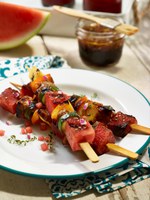Prairie Fare: July is National Watermelon Month
(Click an image below to view a high-resolution image that can be downloaded)
By Julie Garden-Robinson, Food and Nutrition Specialist
NDSU Extension Service
The other day I was at my desk at work, talking to my computer screen, but I wasn’t just being the “absent-minded professor.”
I actually had an audience in a room across the state. Grilling fruits and vegetables was the topic of my webinar.
I mentioned grilling watermelon to the audience because I had read the morning newspaper. Coincidentally, a local writer duo had featured grilled watermelon in their column.
My listeners became very interested in grilled watermelon. They wanted details.
Why had I mentioned something I had not tried? Note to self: Don’t do that next time.
I quickly hopped on the internet and found them some details about the size of the watermelon slices and grilling time. Based on the number of online articles, grilling watermelon is more popular than I would have imagined.
Later that week, I gave grilled watermelon a try. I had some watermelon in my refrigerator, so I sliced the watermelon to a thickness of about 1 1/2 inches and left the rind in place. I brought the slices outside to my personal grillmaster, also known as my husband. He grilled each slice (with the rind) for five minutes on each side.
I drizzled some balsamic vinegar on my slice, which added a little kick of flavor. Many grilled watermelon recipes also recommend sprinkling a little feta cheese on top, but I didn’t have any in my refrigerator.
My husband ate his portion plain. The grilled watermelon had a slightly smoky flavor that complemented the natural sweetness of watermelon.
My grillmaster said, “This is really good.” He looked a little surprised.
July is National Watermelon Month, so enjoy some sweet, juicy watermelon in a variety of ways.
The U.S. is the fourth leading producer of watermelons, and about 50 varieties of watermelon are popular. Watermelons are “cousins” to pumpkins, squash and cucumbers because they are all in the Curcurbitaceae botanical family.
We also have different watermelon colors and sizes available. You can choose from mini, seeded, seedless, yellow and orange types of watermelon. You can slice, dice and scoop the flesh into balls. For a fancy serving container, carve your watermelon to form a basket to hold the watermelon pieces.
Watermelon is about 92 percent water, but it packs a lot of nutritional benefits in that juicy fruit. Two cups of diced watermelon have just 80 calories, no fat, 21 grams of carbohydrate, and 30 percent of the daily vitamin A recommendation and 25 percent of the daily vitamin C recommendation.
Even better, watermelon has some research backing its potential health benefits. Watermelon is the best source of lycopene, a natural pigment that provides watermelon’s rosy color. Fully ripened watermelon is your best source of lycopene.
When you hear the word “lycopene,” tomatoes might come to mind. However, watermelon has more than 1 1/2 times the amount of lycopene than you would find in tomatoes. Lycopene is a powerful antioxidant, and some researchers have linked consuming lycopene-rich foods regularly to reducing the risk of cancer and potentially helping manage blood pressure.
Even the white part of watermelon directly under the rind has some health benefits. The white section is high in a compound known as “citrulline” that is linked to improved heart health.
In fact, you can make watermelon rind pickles safely at home; see http://nchfp.uga.edu/how/can_06/watermelon_rind.html for a recipe from the National Center for Home Food Preservation.
When choosing a watermelon, look for a melon that is heavy for its size and free from bruises, cuts or dents. Be sure to rinse the watermelon thoroughly before cutting, and use a vegetable brush if necessary. Keep cut watermelon refrigerated.
Visit https://www.ag.ndsu.edu/food and check out our grilling information, including a new handout about grilling fruits and vegetables.
Here’s a recipe and nutrition analysis courtesy of the National Watermelon Promotion Board. Visit http://www.watermelon.org/ for more recipes.
Pork and Watermelon Kebobs
6 Tbsp. brown sugar
6 Tbsp. soy sauce
6 Tbsp. diced red onion
3 garlic cloves, minced
3 Tbsp. lemon juice
1 Tbsp. olive oil
1/4 tsp. ground thyme
dash pepper to taste
1 pound boned, lean pork chop, cut into 1-inch cubes (approximately 38 to 40 pieces)
32 (1-inch) cubes watermelon
16 to 24 (1/2-inch) zucchini rounds
16 (1-inch) pineapple chunks, fresh or canned
24 (1-inch) pieces yellow and/or orange peppers
1 bottle cooking spray
Combine sugar, soy sauce, onion, cloves, lemon juice, olive oil, thyme and pepper in a mixing bowl. Pour into a zip-top bag and add pork pieces. Reserve some marinade in a separate bowl for basting. Seal bag, mix thoroughly and refrigerate for at least one hour, turning bag on occasion. Remove pork from bag. Thread five pork pieces, four watermelon cubes, two to three zucchini rounds, two pineapple chunks and three pieces of pepper on each of eight skewers, alternating the order. Heat the grill to medium high. Spray cooking surface with cooking spray and place kebobs on grill. Grill for 12 to 15 minutes, depending on grill heat, or until done, turning and basting frequently with reserved marinade. Garnish with sesame seeds and chunks of watermelon.
Makes eight servings (one kebob each). Each serving has 234 calories, 9 grams (g) fat, 1.8 g fiber and 488 milligrams sodium.
(Julie Garden-Robinson, Ph.D., R.D., L.R.D., is a North Dakota State University Extension Service food and nutrition specialist and professor in the Department of Health, Nutrition and Exercise Sciences.)
NDSU Agriculture Communication - July 13, 2017
| Source: | Julie Garden-Robinson, 701-231-7187, julie.garden-robinson@ndsu.edu |
|---|---|
| Editor: | Ellen Crawford, 701-231-5391, ellen.crawford@ndsu.edu |



